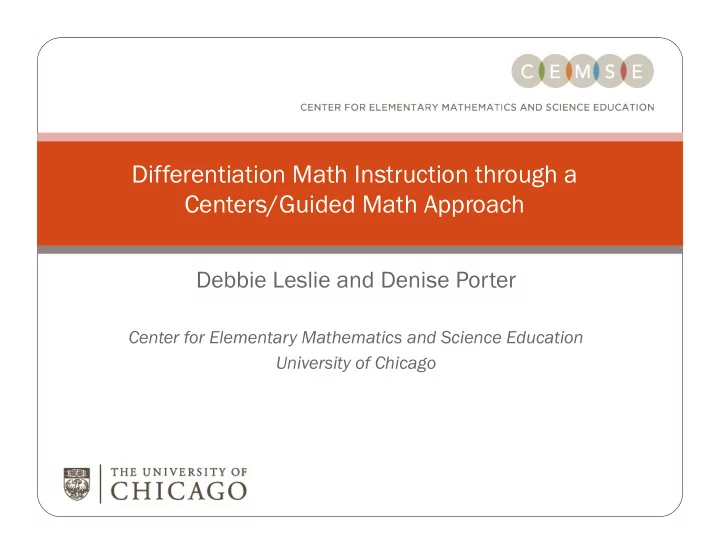

Differentiation Math Instruction through a Centers/Guided Math Approach Debbie Leslie and Denise Porter Center for Elementary Mathematics and Science Education University of Chicago
Just s so y you kno know… We will use content examples that are most relevant for Grades PreK through 2 during the session (number sense)
Getting Started
Getting Started: Guided Math: Brainstorm some benefits and some challenges.
A math workshop model helps you use a range of grouping structures intentionally and flexibly to address your instructional goals.
Discuss the benefits and challenges with a partner or small group.
Mini ni-L -Lesson n
Some me B Bene nefits Provides structures for differentiation New instruction Review and practice Helps children “find their voices” during math time Promotes student independence and ownership of their own learning Can help with pacing/time usage Teachers often improve their own practice through more deliberate planning and intentional implementation Others?
Some me C Cha halle lleng nges Too many kids; too many/few groups; problematic kid combinations Too little time Matching activities to grouping format (not everything works in a small group – especially with no teacher) Logistics (materials, transitions, space, etc.) Accountability (how do I make sure they do what they are supposed to at the Centers?) Assessment Challenges (how can I assess them if I’m not with them?) What to do when you have completed the center? Others?
One ne P Possible le “ “Gu Guided M Math” h” Lesson S n Structure Getting Started (individual, then partner/small group) provide access/promote engagement/involve everyone Mini Lesson (whole group) give everyone access to rich, rigorous core content Small-Group Work (small groups, often leveled) plan for tasks that provide differentiated instruction and practice, targeted to students’ levels and needs plan for varied tasks (e.g., not all paper-and-pencil; not all high-activity, materials-heavy games) plan for tasks that are well-suited to productive work in the absence of a teacher plan for enough time (but not too much) and enough groups (but not too many) plan for accountability (and assessment, when warranted) Closure (format may vary)
A math workshop model helps you use a range of grouping structures intentionally and flexibly to address your instructional goals.
Sample Planning Template ,GHI=J' !! 2KL!I=J !! MLIHL!I=J !! 2NKO!I=J !! POQI=J !! (&--*01'!-"4-&+'' (&--*01'!-"4-&+' ! (&--*01'!-"4-&+' ! (&--*01'!-"4-&+' ! (&--*01'!-"4-&+' ! ! ! ,*0*RS&55:0'' ,*0*RS&55:0' ! ,*0*RS&55:0' ! ,*0*RS&55:0' ! ,*0*RS&55:0' ! ! ! 3&0-&4'T'92&">.&4;' ! 3&0-&4'T'92&">.&4;' ! 3&0-&4'T'92&">.&4;' ! 3&0-&4'T'92&">.&4;' ! 3&0-&4'T'92&">.&4;' ! ! ! ! ! ' ! ! ' ! ' ! ' ' ' 3&0-&4'U'9("#&V,"0*$)%"-*7&5;' 3&0-&4'U'9("#&V,"0*$)%"-*7&5;' 3&0-&4'U'9("#&V,"0*$)%"-*7&5;' 3&0-&4'U'9("#&V,"0*$)%"-*7&5;' 3&0-&4'U'9("#&V,"0*$)%"-*7&5;' ! ! ' ! ! ! ! ! ! ! ! ! ! 3&0-&4'W'9/"$&4'"0+'/&0>*%;' 3&0-&4'W'9/"$&4'"0+'/&0>*%;' 3&0-&4'W'9/"$&4'"0+'/&0>*%;' 3&0-&4'W'9/"$&4'"0+'/&0>*%;' 3&0-&4'W'9/"$&4'"0+'/&0>*%;' ! ' ! ! ' ! ! ! ! ! ! ! ! 3&0-&45'"4&'6%&7&%&+8'961)*+&+'#"-.8'14:)$5;<'=>-*7*-*&5'"-'&">.'>&0-&4'"4&'"$$4:$4*"-&%?'+*@@&4&0-*"-&+<'' A&'5)4&'-:'$%"0'"$$4:$4*"-&B'&01"1*01'6C.&0'?:)'"4&'@*0*5.&+8'">-*7*-*&5''9$4:D&>-5B'>.:*>&E:"4+'#&0)5B'$">F&-5B'&-><;' '
A Centers Board
A Variation Ms. R’s Math Period Time Groupings Activities 5-10 minutes Whole group Math message 15-20 minutes Group A Teacher Center/lesson Group B Journal Pages/Math Boxes Group C Writing about Math/Games 15-20 minutes Group A Journal Pages/Math Boxes Group B Writing about Math/Games Group C Teacher Center/lesson 15-20 minutes Group A Writing about Math/Games Group B Journal Pages/Math Boxes Group C Teacher Center/lesson
Ms. G’s Approach (Kindergarten) Minilesson on the rug 1. Math Work Time 2. Math trays Students are dismissed to choose a tray Students choose to either work alone or with a partner Trays are all tied to state math standards, Students are trained to work on a tray until they have completed it, then they return the tray and select another one For example, mid-year the teacher has 20 trays available including Roll and Record, Empty the Cup, and Measuring Lengths. Teacher is able to spend differentiated teaching time with individuals and small groups and record ongoing assessments.
Small Group/Center Work Number Sense Activities
What does number sense mean to you?
Number sense can be described as … “ … good intuition about numbers and their relationships. It develops gradually as a result of exploring numbers, visualizing them in a variety of contexts, and relating them in ways that are not limited by traditional algorithms.” Howden,1989, p. 11
Possible le f forma mats f for Sma mall-Gr ll-Group/Cent nter W Work k Teacher-Facilitated Games/Manipulatives Paper and Pencil Activities
Questions ns t to C Cons nsider a and nd Di Discuss What aspects of number sense does this activity develop? How might these activities be tailored for kids at different levels? How do these activities promote students’ independence and ownership over their own learning What sorts of accountability might you build in? How might this support assessment?
Clo losure
Revisiting ng C Cha halle lleng nges Too many kids; too many/few groups; problematic kid combinations Too little time Matching activities to grouping format (not everything works in a small group – especially with no teacher) Logistics (materials, transitions, space, etc.) Accountability (how do I make sure they do what they are supposed to at the Centers?) Assessment Challenges (how can I assess them if I’m not with them?) What to do when you have completed the center? Others?
Some me T Tips f for S Success Start small; set and practice norms and expectations Not necessarily every day/every lesson Fewer groups may be better (3 or 4 may be a magic number) Think carefully about: Whether the activity is a good Center activity Who’s in what group? Might partners within groups help? What order will they rotate through the centers? Where will they work? Others?
Differentiation Math Instruction through a Centers/Guided Math Approach Debbie Leslie and Denise Porter Center for Elementary Mathematics and Science Education University of Chicago daleslie@uchicago.edu porterd@uchicago.edu
Recommend
More recommend